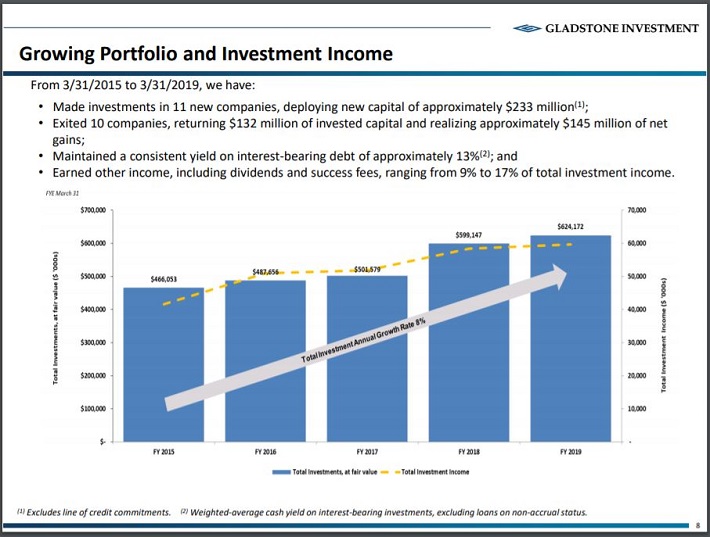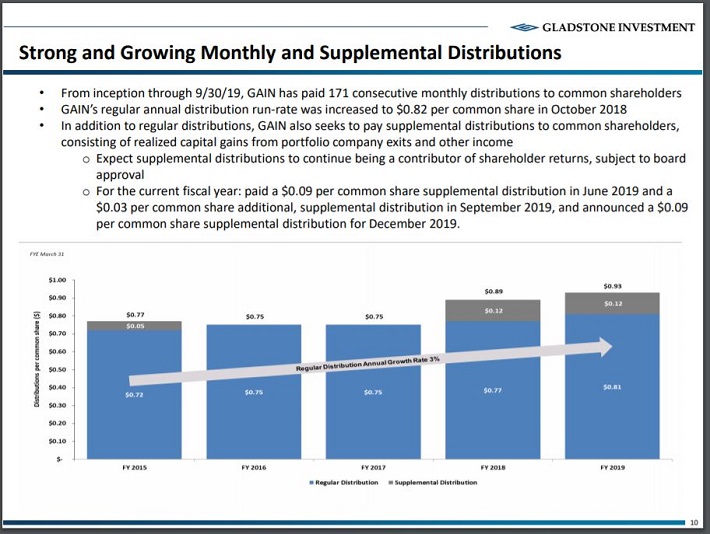Updated on March 6th, 2020 by Nathan Parsh
It is not hard to see why Business Development Companies—or BDCs—are popular investments among income investors.
Consider that the S&P 500 Index currently has an average dividend yield of just 19%. With the 10-year U.S. Treasury Bond recently falling below 1%, bonds are not much better right now. This underscores the challenge for income investors. In a climate of low interest rates, yields are very low.
Meanwhile, BDCs typically offer very high dividend yields. For example, Gladstone Investment Corporation (GAIN) is a BDC with a current dividend yield of nearly 8% when supplemental dividends are taken into account.
And, it is one of a select few stocks that pays its dividend each month, rather than each quarter. GAIN is one of 58 monthly dividend stocks.
We have compiled a full list of monthly dividend stocks. You can download our full Excel spreadsheet of all monthly dividend stocks (along with metrics that matter like dividend yield and payout ratio) by clicking on the link below:
It is one of 390 stocks with a 5%+ dividend yield. You can see the full list of established 5%+ yielding stocks by clicking here.
GAIN stock has a combination of a high yield and monthly payouts, which on the surface is very attractive for income investors. But of course, investors should assess the quality of GAIN’s business, its future growth potential, and the sustainability of the dividend before buying shares.
This article will discuss GAIN’s business model, and whether the sky-high dividend yield is too good to be true.
Business Overview
GAIN is a Business Development Company that places debt and equity investments in small and medium privately-held companies, which are at an early stage of development. These companies usually have annual revenues in the range of $5 to $50 million.
A collection of GAIN’s portfolio investments is as follows:
Source: Investor Presentation, slide 14.
The trust’s debt investments primarily consist of senior term loans, senior subordinated loans, and junior subordinated loans.
On the equity side, investments primarily consist of preferred or common stock, or options as a means of acquiring stock. Equity investments are usually made in anticipation of a buyout or some form of recapitalization. Investments are made in the lower-middle market segment, meaning companies that are medium-sized. GAIN intends its portfolio to have a 75%-25% split between debt and equity investments.
GAIN makes money in two ways. First, when its investments are successful, it will realize capital gains. In addition, it receives interest and dividend income from securities held. As of December 31st, 2019, the portfolio consisted of equity or loans in 29 companies, located in 17 U.S. states and in 14 different industry groups.
The company aims to invest in businesses that provide stable earnings and cash flow, which GAIN can use to pay operating expenses, meet its own debt obligations, and make distributions to shareholders with residual cash flow.
Growth Prospects
GAIN’s investment strategy has been very successful over the past several years. From 2015 through the first three quarters of fiscal year 2019, GAIN’s portfolio value grew at an annualized rate of 8%.
An image of the company’s investment income growth since 2015 can be seen in the below image.
Source: Investor Presentation, slide 8.
One important factor for GAIN moving forward is interest rates. Since it predominantly invests in debt securities, rising interest rates could be a negative drag. Fortunately, interest rate hikes appear to be off the table for the foreseeable, especially in light of the 50 basis point reduction that the was announced earlier this week.
In addition, the vast majority of GAIN’s debt portfolio is variable-rate, with a floor or minimum. This will help protect interest income in a rising-rate environment. Continued growth going forward will rely on the successful implementation of the investment strategy, which appears likely, given the company’s history of proven results.
We expect 3%-4% annual NII-per-share growth over the next five years, which we believe is a reasonable estimate of future growth given all of the above factors. GAIN shareholders benefit from the company’s strong investment performance, although whether this performance would hold up in a recession is a different question.
Competitive Advantages & Recession Performance
GAIN also has a durable competitive advantage due to its unique expertise in the lower middle market private debt & equity segment. Lower middle market companies are broadly defined as those with between $5 million and $50 million of annual revenue.
This segment is generally too small for commercial banks to lend to, but too large for the small business representatives of retail banks to lend to. GAIN fills this gap. By putting money to work in this unloved group of private companies, GAIN can realize outsized returns compared to its larger commercial bank counterparts.
Listed below is GAIN’s net-investment-income-per-share and distribution per share both before, during and after the last recession:
- Net-investment-income-per-share 2007 – $0.67
- Net-investment-income-per-share 2008 – $0.79 (18% increase)
- Net-investment-income-per-share 2009 – $0.62 (22% decrease)
- Net-investment-income-per-share 2010 – $0.48 (23% decrease)
The company’s historical distributable net income during the Great Recession is shown below:
- Distributable-net-investment-income 2007 – $0.85
- Distributable-net-investment-income 2008 – $0.93 (9% increase)
- Distributable-net-investment-income 2009 – $0.96 (3% increase)
- Distributable-net-investment-income 2010 – $0.48 (50% decrease)
GAIN saw severe declines in net-investment-income-per-share during the last recession, though the company did return to growth by 2011. Results for this metric have varied from year to year since then.
Meanwhile, distributable-net-investment-income managed to increase during the last recession, but was cut in half in 2010. Distributable-net-investment-income for the current fiscal year is expected to be $0.82 per share, the highest total since 2009.
Dividend Analysis
One reason why BDCs like GAIN can pay high dividends is because of a favorable tax structure. GAIN qualifies as a regulated investment company. As such, it generally is not subject to income taxes, so long as it distributes taxable income to shareholders.
GAIN is a very attractive stock for dividend investors. It pays a monthly dividend of $0.07 per share. On an annualized basis, the $0.84 per-share dividend represents an 6.8% dividend yield.
The company has made more than 162 consecutive monthly dividends since inception. Over the past five years, dividends have grown by 25%.
Source: Investor Presentation, slide 10.
Not only that, but GAIN also provides supplemental dividends from undistributed capital gains and investment income. For example, the company announced a $0.09 per-share supplemental dividend payment for December 2019 and a $0.03 per-share supplemental dividend payment for September 2019.
Going forward, GAIN plans to make two such supplemental dividend payments each year. Including supplemental dividends, the yield is 7.7%.
GAIN has a modest capital structure, which helps secure the dividend. Leverage was less than 35% of total assets, as of December 31st, 2018. And, the company has solid liquidity—the fair value of GAIN’s assets more than triple that of all liabilities.
GAIN reduced its dividend by half from 2009 to 2010, but has generally increased it since. We should note that net income and distributions remain below pre-crisis levels. In addition, the company’s payout ratio is extremely high, even for a BDC. The payout ratio is expected to be above 93% for the current year and has been near or above 100% for the past five years.
As a result, there is some concern as to the level of dividend sustainability. Investors should closely monitor the company’s quarterly financial results–and specifically its dividend coverage–going forward.
Final Thoughts
GAIN’s strongest competitive advantage is its investment strategy, which is to make long-term investments in high-quality businesses, with strong management teams. This has produced strong results for GAIN since inception.
Plus, shareholders can expect GAIN to make two supplemental dividend payments each year, when its investment strategy performs well. Investors depending on income from their holdings, however, should be aware that the company cut its dividend in 2010.
While the dividend yield is likely attractive to income investors, we feel that the payout ratio would likely result in another dividend cut during the next economic downturn. As such, we have a sell rating on shares of Gladstone Investment Corporation.








